LinkedHashMap
LinkedHashMap
大多数情况下,只要不涉及线程安全问题,Map基本都可以使用HashMap,不过HashMap有一个问题,就是迭代HashMap的顺序并不是HashMap放置的顺序,也就是无序。HashMap的这一缺点往往会带来困扰,因为有些场景,我们期待一个有序的Map。
LinkedHashMap解决了这个问题,它虽然增加了时间和空间上的开销,但是通过维护一个运行于所有条目的双向链表,LinkedHashMap保证了元素迭代的顺序。
关注点
| 集合关注点 | 结论 |
|---|---|
| LinkedHashMap是否允许空 | Key和Value都允许为空 |
| LinkedHashMap是否允许重复数据 | Key重复会覆盖、Value允许重复 |
| LinkedHashMap是否有序 | 有序 |
| LinkedHashMap是否线程安全 | 非线程安全 |
基本数据结构
关于LinkedHashMap,先提两点:
- LinkedHashMap可以认为是HashMap+LinkedList,即它既使用HashMap操作数据结构,又使用LinkedList维护插入元素的先后顺序
- LinkedHashMap的基本实现思想就是 — 多态。可以说,理解多态,再去理解LinkedHashMap原理会事半功倍;反之也是,对于LinkedHashMap原理的学习,也可以促进和加深对于多态的理解。
为什么可以这么说,首先看一下,LinkedHashMap的定义:
1 | public class LinkedHashMap<K,V> extends HashMap<K,V> implements Map<K,V> { |
看到,LinkedHashMap是HashMap的子类,自然LinkedHashMap也就继承了HashMap中所有非private的方法。再看一下LinkedHashMap中本身的方法:
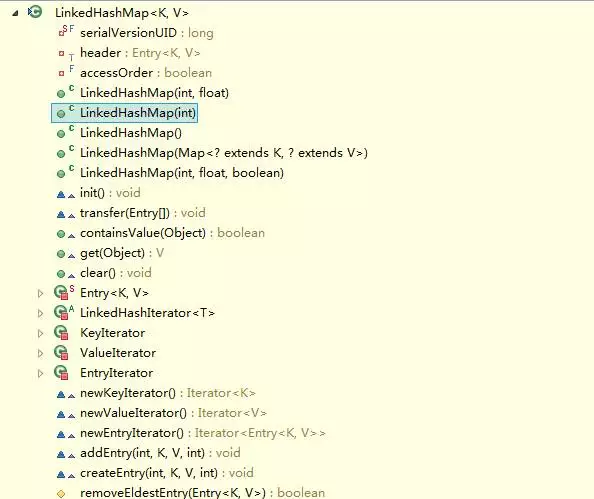
看到LinkedHashMap中并没有什么操作数据结构的方法,也就是说LinkedHashMap操作数据结构(比如put一个数据),和HashMap操作数据的方法完全一样,无非就是细节上有一些的不同罢了。
LinkedHashMap和HashMap的区别在于它们的基本数据结构上,看一下LinkedHashMap的基本数据结构,也就是Entry:
1 | private static class Entry<K,V> extends HashMap.Entry<K,V> { |
列一下Entry里面有的一些属性吧:
- K key
- V value
- Entry<K, V> next
- int hash
- Entry<K, V> before
- Entry<K, V> after
其中前面四个,也就是红色部分是从HashMap.Entry中继承过来的;后面两个,也就是蓝色部分是LinkedHashMap独有的。不要搞错了next和before、After,next是用于维护HashMap指定table位置上连接的Entry的顺序的,before、After是用于维护Entry插入的先后顺序的。
还是用图表示一下,列一下属性而已:
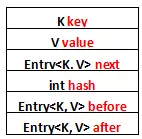
初始化LinkedHashMap
假如有这么一段代码:
1 | public static void main(String[] args) { |
首先是第2行,new一个LinkedHashMap出来,看一下做了什么:
1 | public LinkedHashMap() { |
这里出现了第一个多态:init()方法。尽管init()方法定义在HashMap中,但是由于:
- LinkedHashMap重写了init方法
- 实例化出来的是LinkedHashMap
因此实际调用的init方法是LinkedHashMap重写的init方法。假设header的地址是0×00000000,那么初始化完毕,实际上是这样的:
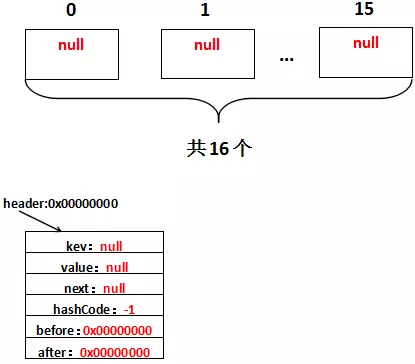
添加元素
继续看LinkedHashMap添加元素,也就是put(“111″,”111″)做了什么,首先当然是调用HashMap的put方法:
1 | public V put(K key, V value) { |
第16行又是一个多态,因为LinkedHashMap重写了addEntry方法,因此addEntry调用的是LinkedHashMap重写了的方法:
1 | void addEntry(int hash, K key, V value, int bucketIndex) { |
因为LinkedHashMap由于其本身维护了插入的先后顺序,因此LinkedHashMap可以用来做缓存,第5行~第7行是用来支持FIFO算法的,这里暂时不用去关心它。看一下createEntry方法:
1 | void createEntry(int hash, K key, V value, int bucketIndex) { |
第2行~第4行的代码和HashMap没有什么不同,新添加的元素放在table[i]上,差别在于LinkedHashMap还做了addBefore操作,这四行代码的意思就是让新的Entry和原链表生成一个双向链表。假设字符串111放在位置table[1]上,生成的Entry地址为0×00000001,那么用图表示是这样的:
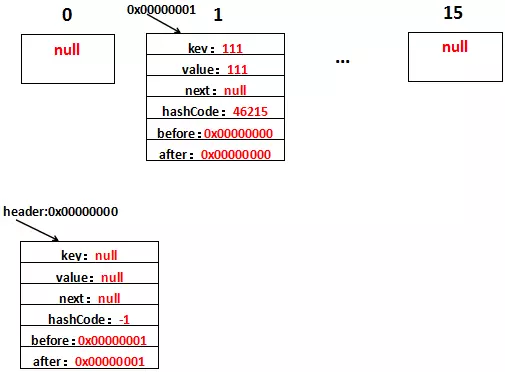
如果熟悉LinkedList的源码应该不难理解,还是解释一下,注意下existingEntry表示的是header:
- after=existingEntry,即新增的Entry的after=header地址,即after=0×00000000
- before=existingEntry.before,即新增的Entry的before是header的before的地址,header的before此时是0×00000000,因此新增的Entry的before=0×00000000
- before.after=this,新增的Entry的before此时为0×00000000即header,header的after=this,即header的after=0×00000001
- after.before=this,新增的Entry的after此时为0×00000000即header,header的before=this,即header的before=0×00000001
这样,header与新增的Entry的一个双向链表就形成了。再看,新增了字符串222之后是什么样的,假设新增的Entry的地址为0×00000002,生成到table[2]上,用图表示是这样的:

就不细解释了,只要before、after清除地知道代表的是哪个Entry的就不会有什么问题。
总得来看,再说明一遍,LinkedHashMap的实现就是HashMap+LinkedList的实现方式,以HashMap维护数据结构,以LinkList的方式维护数据插入顺序。
利用LinkedHashMap实现LRU算法缓存
前面讲了LinkedHashMap添加元素,删除、修改元素就不说了,比较简单,和HashMap+LinkedList的删除、修改元素大同小异,下面讲一个新的内容。
LinkedHashMap可以用来作缓存,比方说LRUCache,看一下这个类的代码,很简单,就十几行而已:
1 | public class LRUCache extends LinkedHashMap { |
顾名思义,LRUCache就是基于LRU算法的Cache(缓存),这个类继承自LinkedHashMap,而类中看到没有什么特别的方法,这说明LRUCache实现缓存LRU功能都是源自LinkedHashMap的。LinkedHashMap可以实现LRU算法的缓存基于两点:
- LinkedList首先它是一个Map,Map是基于K-V的,和缓存一致
- LinkedList提供了一个boolean值可以让用户指定是否实现LRU
那么,首先我们了解一下什么是LRU:LRU即Least Recently Used,最近最少使用,也就是说,当缓存满了,会优先淘汰那些最近最不常访问的数据。比方说数据a,1天前访问了;数据b,2天前访问了,缓存满了,优先会淘汰数据b。
我们看一下LinkedList带boolean型参数的构造方法:
1 | public LinkedHashMap(int initialCapacity, float loadFactor, boolean accessOrder) { |
就是这个accessOrder,它表示:
(1)false,所有的Entry按照插入的顺序排列
(2)true,所有的Entry按照访问的顺序排列
第二点的意思就是,如果有1 2 3这3个Entry,那么访问了1,就把1移到尾部去,即2 3 1。每次访问都把访问的那个数据移到双向队列的尾部去,那么每次要淘汰数据的时候,双向队列最头的那个数据不就是最不常访问的那个数据了吗?换句话说,双向链表最头的那个数据就是要淘汰的数据。
“访问”,这个词有两层意思:
- 根据Key拿到Value,也就是get方法
- 修改Key对应的Value,也就是put方法
首先看一下get方法,它在LinkedHashMap中被重写:
1 | public V get(Object key) { |
然后是put方法,沿用父类HashMap的:
1 | public V put(K key, V value) { |
修改数据也就是第6行~第14行的代码。看到两端代码都有一个共同点:都调用了recordAccess方法,且这个方法是Entry中的方法,也就是说每次的recordAccess操作的都是某一个固定的Entry。
recordAccess,顾名思义,记录访问,也就是说你这次访问了双向链表,我就把你记录下来,怎么记录?把你访问的Entry移到尾部去。这个方法在HashMap中是一个空方法,就是用来给子类记录访问用的,看一下LinkedHashMap中的实现:
1 | void recordAccess(HashMap<K,V> m) { |
看到每次recordAccess的时候做了两件事情:
- 把待移动的Entry的前后Entry相连
- 把待移动的Entry移动到尾部
当然,这一切都是基于accessOrder=true的情况下。最后用一张图表示一下整个recordAccess的过程吧:
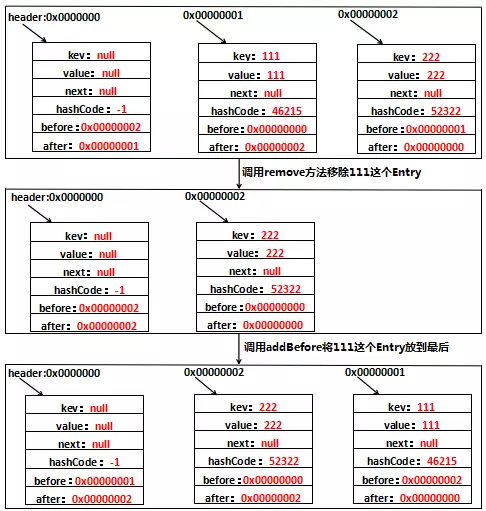
演示LinkedHashMap按照访问顺序排序的效果
示例代码:
1 | public class LinkedHashMapSample { |
注意这里的构造方法要用三个参数那个且最后的要传入true,这样才表示按照访问顺序排序。
运行结果:
1 | 111=111 222=222 333=333 444=444 |
结论:
- LinkedList是有序的;
- 每次访问一个元素(get或put),被访问的元素都被提到最后面去了。




